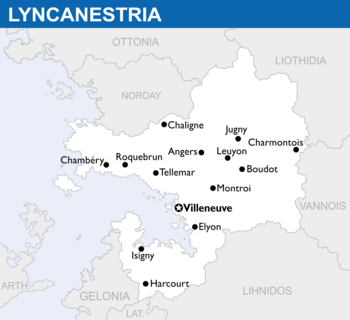Lyncanestria
Empire of Lyncanestria Empire de Lyncanestrie (Audonic) | |
|---|---|
Coat of arms
| |
| Motto: Qu’il y ait justice, effondre le ciel ("Let justice be done though the heavens fall") | |
| Anthem: Hymne à la nation Hymn to the Nation | |
 Location of Lyncanestria (dark green) – in Belisaria (green & dark grey) – in the Belisarian Community (light green) | |
 Political map of Lyncanestria | |
| Capital and largest city | Villeneuve |
| Official language and national language | Audonic |
| Ethnic groups (2015) |
|
| Religion |
|
| Demonym(s) | Lyncanestrian |
| Government | Federal parliamentary elective monarchy |
• Emperor | Philippe IV |
| Luc Mariard | |
| Legislature | Imperial Diet |
| Federal Council | |
| Chamber of Deputies | |
| Establishment | |
• Christianization of Audonia | 2nd century AD |
• Holy Audonian Empire founded | 1100 |
• Treaty of X | 1858 |
• Constitution promulgated | 27 October 1863 |
• Formation of the BC | 18 March 1959 |
| Population | |
• 2019 estimate | 67,200,000 |
• 2015 census | 63,854,527 |
• Density | 117.69/km2 (304.8/sq mi) |
| GDP (PPP) | 2018 estimate |
• Total | $2.773 trillion |
• Per capita | $41,540 |
| HDI | 0.887 very high |
| Currency | Écu (ℰ) (LYE) |
| Date format | dd/mm/yyyy (AD) |
| Driving side | left |
| Calling code | +4 |
| ISO 3166 code | LY |
| Internet TLD | .ly |
Lyncanestria (Audonic: Lyncanestrie, /linkɑ̃'stʁi/), officially the Empire of Lyncanestria (Audonic: Empire de Lyncanestrie), is a sovereign state in Ajax, located on the continent of Belisaria. The country shares seven land borders—Norday and Ottonia to the north, Liothidia and Vannois to the east, Gelonia, Lihnidos and Latium to the south—and one maritime border—Arthurista. Since 1959, Lyncanestria has been part of the Belisarian Community.
Etymology
History
Prehistory
The first traces of hominid migration into modern Lyncanestria occurred approximately 1.8 million years ago as early hunter-gatherer societies moved from Scipia and Ochran. Throughout prehistoric times the Lyncanestrian region was harsher, and affected by numerous glacial eras. Archaeologists have found tools dating from around 70,000 B.C.E. indicating specialization. The Gémus mountains are home to numerous decorated caves dating to the upper Paleolithic era. By 6,000 B.C.E., the peoples of the Lyncanestrian basin had become sedentary and began agricultural civilization.
Early history
Lyncanestrian antiquity is characterized by numerous Audonic chieftains vying for regional supremacy. In the X century, Latin military presence began to subjugate and annex Lyncanestria into their empire.
Audonian Empire
Independence and modernization
Contemporary Lyncanestria
Politics
Government
Lyncanestria is a parliamentary democracy where legislative authority is vested in the Imperial Diet, seated in Villeneuve. The Diet is a bicameral body, comprising the lower Chamber of Deputies with 641 seats, elected by popular vote every five years; and the upper Federal Council with 115 seats, whose members are appointed by the legislatures of the states which they represent for three year terms. The representative government operates in conjunction with a constitutional monarch, who is is elected by the Federal Council and serves for life. The power of the monarch is mostly ceremonial, and primarily serves as a figurehead for national unity. Executive power is wielded chiefly by the Prime Minister and his Council.
Federal constituencies
Lyncanestria uses a federal system of government.
Law and justice
Foreign relations
International diplomacy is the responsibility of the Ministry of Foreign Affairs. Lyncanestria maintains a working embassy in all Belisarian countries, as well as in many other countries abroad. In the twenty-first century, Lynacnestrian foreign policy has been focused on strengthening its diplomatic and economic relations to the Belisarian Community, of which Lyncanestria is a founding member. Since 1966, Lyncanestria has been a member of the Forum of Nations.
Military
Economy
Geography
Demographics
Population
Lyncanestria's population was 63,854,527 in the 2015 national census. In recent years, natural population growth has decreased, though the birth rate remains positive. The fertility rate in Lyncanestria in 2016 was 1.89. Today, most population change is due to immigration. As of 2019, the population is estimated at 67.2 million.
Ethnically, most Lyncanestrians are of Audonic-Celtic origin, with admixture of Italic and Germanic groups going back to the early second and third centuries C.E. Immigration in recent years has led to the creation of a more multicultural society, as the percentage of people who are foreign-born or have foreign-born parents has seen a steady rise.
